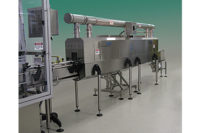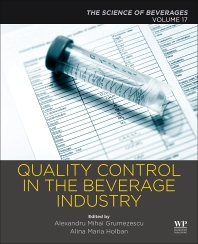Different Waves For Different Brews
The U.S. Beer Industry Experienced a Slight Decline in 2005, Dropping Total Shipments 0.1 Percent, According to the Beer Institute. but While General-market Domestic Beers Continue To struggle, High-end Products are Enjoying Growth in the High Single-digits.
Import beer shipments grew 7.2 percent, and craft beer
shipments were up 9 percent — and they carried that momentum into the
first part of this year.
Through June 18, IRI reports that retail dollar sales
in the domestic beer category are down 1.2 percent in supermarkets, drug
stores and mass merchandisers (FDM), excluding Wal-Mart. Imports and
micro/craft beers showed impressive gains through all channels, with
imports growing almost 10.5 percent to nearly $1.8 billion and micros/craft
beers gaining 12.7 percent to $452.4 million.
Although shipments were down, retail dollar sales
improved, with the discrepancies between the segments’ performance
attributed to consumers’ willingness to trade up to more expensive
products and their desire for choice.
| Global beer volume (MILLIONS OF LITERS) | ||
| SUBSECTOR | 2005 | FORECAST 2006 |
| DARK BEER | 5,906.7 | 6,014 |
| STOUT | 1,735.8 | 1,771.6 |
| NON-/LOW –ALCOHOL | 2,076.3 | 2,199.7 |
| TOTAL BEER | 155,244.1 | 159,989 |
| Source: Euromonitor International, 2006 | ||
The big brewers, Anheuser-Busch in particular, have
come out swinging this year with a number of new specialty-type brands.
Anheuser-Busch recently added Singapore’s Tiger Beer to its lineup to
increase its position in the import market, and plans to increase
Tiger’s currently limited distribution to nationwide exposure. The
company also took over the Grolsch Lager business from United States
Brewing this spring, several months ahead of schedule in order to get the
brand in its system before the summer selling season. In addition, A-B
introduced Peels, a malt beverage made with juice to appeal to female
consumers. Other innovative A-B offerings include organic Wild Hop and
Stone Mill beers, Spring Heat Spice Wheat, and Spykes flavor shots, which
are made to be mixed with beer so consumers can customize flavors.
As for its more traditional products, A-B’s Bud
Light and Budweiser brands continue to lead the beer category, with nearly
25 percent combined market share in FDM channels, according to IRI. Bud
Light managed to grow 1.1 percent as of June 19, while Budweiser is still
seeing sales decline with a 7.3 percent decrease. Competitors Miller Lite
and Coors Light pulled off sales gains, with Miller Lite picking up a
slight 0.7 percent sales gains and Coors Light growing 3 percent.
Miller Brewing Co. has taken a slightly different tack
to Anheuser-Busch’s innovation efforts to help boost sales. The
company has spent the past months revamping its brand images with
advertising that plays up the premium quality of its products. Indicating
that the beer industry has allowed its marketing to become too lowbrow,
Miller Chief Executive Officer Norman Adami earlier this year told a group
of beer industry observers, “We believe the single biggest factor
determining the success or failure of each of our brands is the quality of
the marketing behind those brands.”
| Top domestic beers (individual brands) | |||||||
| VS. BRAND | DOLLAR% SALES | CHANGE VS. PRIOR YEAR | MARKET SHARE |
% CHANGE PRIOR YEAR | |||
| BUD LIGHT | $1,346,753,280 | 1.1 | 15.4 | -0.1 | |||
| BUDWEISER | $782,950,400 | -7.3 | 8.9 | -0.9 | |||
| MILLER LITE | $713,175,680 | 0.7 | 8.1 | -0.1 | |||
| COORS LIGHT | $603,865,280 | 3.0 | 6.9 | 0.1 | |||
| NATURAL LIGHT | $285,951,616 | -0.1 | 3.3 | -0.1 | |||
| MICHELOB ULTRA LIGHT | $208,512,176 | -14.6 | 2.4 | -0.5 | |||
| BUSCH LIGHT | $203,824,256 | 3.1 | 2.3 | 0.0 | |||
| MILLER GENUINE DRAFT | $178,441,024 | -9.7 | 2.0 | -0.3 | |||
| MILLER HIGH LIFE | $173,374,544 | -6.0 | 2.0 | -0.2 | |||
| BUSCH | $169,905,360 | -3.5 | 1.9 | -0.1 | |||
| CATEGORY TOTAL | $6,085,234,176 | -1.2 | 69.5 | -2.0 | |||
| Source: Information Resources Inc., Total food, drug and mass merchandise (excluding Wal-Mart) for the 52 weeks ending June 18, 2006. | |||||||
The company re-tagged its Miller Genuine Draft as
“Beer. Grown Up.” and has put renewed focus behind import
brands Peroni as “refreshment with Italian style and
sophistication,” and Pilsner Urquell as “the beer
aficionado’s beer.”
Adami also emphasized that he believes beer pricing
wars are damaging to the industry.
“Commoditized industries are usually governed by
two laws — whoever is cheapest wins … and whoever has the scale
is cheapest. As the much smaller player, we have every reason in the world
to seek sensible pricing,” he said.
| Top imported beers (individual brands) | |||||
| BRAND | DOLLAR % SALES | CHANGE VS.PRIOR YEAR | MARKET SHARE | % CHANGE VS.PRIOR YEAR | |
| CORONA EXTRA | $467,633,248 | 10.1 | 5.3 | 0.4 | |
| HEINEKEN | $289,937,760 | 10.5 | 3.3 | 0.3 | |
| CORONA LIGHT | $115,754,640 | 10.7 | 1.3 | 0.1 | |
| TECATE | $81,473,616 | 8.4 | 0.9 | 0.1 | |
| LABATT BLUE | $49,865,544 | -5.4 | 0.6 | 0.0 | |
| AMSTEL LIGHT | $48,372,172 | 3.4 | 0.6 | 0.0 | |
| MODELO ESPECIAL | $46,966,472 | 39.8 | 0.5 | 0.1 | |
| BECKS | $46,273,352 | 4.2 | 0.5 | 0.0 | |
| GUINNESS DRAUGHT | $44,843,888 | 6.4 | 0.5 | 0.0 | |
| NEWCASTLE BROWN ALE | $42,634,696 | 18.0 | 0.5 | 0.1 | |
| CATEGORY TOTAL | $1,762,464,768 | 10.5 | 20.1 | 1.6 | |
| Source: Information Resources Inc., Total food, drug and mass merchandise (excluding Wal-Mart) for the 52 weeks ending June 18, 2006. | |||||
Coors Brewing Co. is focusing its efforts on its
Rockies image with new packaging and a “Taste the Cold”
tagline. The company rolled out new aluminum bottles with liners to keep
beer colder longer. The company also released Stay-Cold Glassware made from
borosilicate glass for the on-premise market.
A lesser-known Coors brand, Blue Moon Belgian White,
has quietly performed very well for the company. The brand has enjoyed
double-digit growth during the past three years, and is particularly
popular on-premise where it plays up its coriander and orange peel content
by being served with an orange slice.
Craft beers boasted the largest growth of any beer
segment, and according to a recent Citigroup wholesaler survey, beer
distributors think the major brewers should consider adding micros to the
mix. Sixty-four percent of wholesalers surveyed thought the major brewers
should add craft beers through acquisition, but leave the smaller companies
to operate independently. The wholesalers also indicated that within more
traditional offerings, seasonal beers have the best chance at raising the
image of beer with consumers.
Demonstrating that Citigroup’s wholesaler survey
was correct, Anheuser-Busch has been investing in Chicago’s Goose
Island Beer Co. via its interest in Widmer Brothers Brewing. Widmer, based in Oregon, has acquired a minority share of
Goose Island. A-B in turn, owns a stake in Widmer, giving the Chicago
brewer access to a wider distribution network. BI



